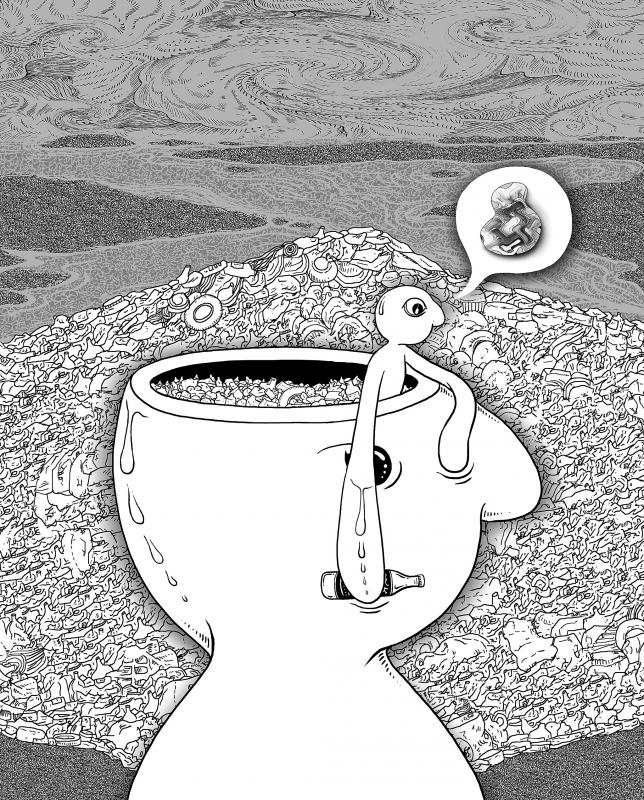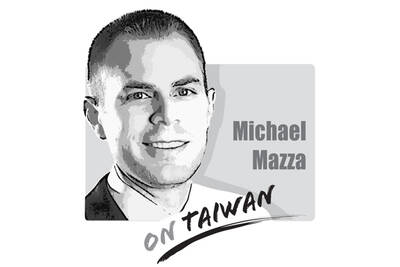As much as the idea might be unpalatable, all of our diets are now likely to include tiny servings of plastic.
The places where microplastics and plastic fibers have been found is beginning to read like a supermarket shopping list.
Studies have found microplastics — that is, pieces or fibers smaller than 5mm — in foods including tea, salt, seaweed, milk, seafood, honey, sugar, beer, vegetables and soft drinks. Tap water contains plastic. Bottled water contains even more.

Illustration: Mountain People
Across our terrestrial and marine environments, microplastics have been found in most places where scientists have looked, including some of the most remote spots on Earth, threatening and, in some cases killing, wildlife.
However, when it comes to the effect of omnipresent plastic on human health, what is the risk?
“Nobody really knows the answer, but the absence of evidence is not evidence of absence,” says Mark Taylor, a professor at Macquarie University in Sydney and an expert on environmental contamination.
This month, a study of rice bought from supermarkets and a bulk-food store in Queensland, Australia, became the latest to deliver a warning.
Researchers found plastic in every sample, whether the rice was grown in Australia, India, Thailand or Pakistan, and whether the rice was packaged in plastic or paper.
Washing the rice reduced the amount of plastic likely to be ingested, but the study used special filtered water for rinsing. Most households only have access to tap water — which contains microplastics.
Precooked rice — the kind that comes in microwaveable sachets — had the most plastic, but the amounts are tiny.
The study says that a 100g serving of rice typically contains 3.7mg of microplastics if it is unwashed, 2.8mg if it is washed or 13.3mg for instant rice (in the microwaveable pouches).
A single grain of rice weighs roughly 30mg.
Jake O’Brien, a lead author of the study from the Queensland Alliance for Environmental Health Sciences, says the higher levels of plastic in precooked samples was more likely down to the extra processing it goes through before it is packaged, rather than the plastic packaging itself.
According to the study, there are multiple opportunities for rice to pick up plastics, from the soils to the machines used to pick, store, move and process the rice, to the packaging and handling.
For an average Australian’s rice consumption, this would equal about 1g a year of plastic.
O’Brien has also been finding levels of microplastics in prawns, oysters and sardines.
He also took part in a study that found microplastics in the solid sludge left over at sewage works.
That sludge — known as biosolids — is widely used as a fertilizer and soil improver on agricultural land. Some scientists have asked if this process means agricultural soils are an unforeseen dump for domestic microplastics.
Our exposure to tiny pieces of plastic is not limited to what we drink or eat. A team from Macquarie University took samples of airborne dust from homes and in a study released earlier this month found that about 40 percent of it was plastic.
Microplastic is clearly making its way into our bodies, because it has been found in human poo.
Scientists in Italy developed a plastic-free protocol in a hospital delivery room, and then examined placentas. They found microplastics there, too.
Taylor, who carried out the dust study, says it would be “overreach” to say there are demonstrable effects on our health from ingesting microplastics, but he stresses that this does not mean future studies will not find problems.
“It would be prudent and smart for people to reduce plastics in their home where that’s possible,” he said. “Do we really need all those plastic food containers?”
Ian Musgrave, a toxicologist at the University of Adelaide, says that knowing if microplastics are harmful to humans is hard to untangle when we are exposed to so many other substances.
“It is enormously difficult, because we live in an environment with lots of other things,” Musgrave says. “We have a saying though, that it is the dose that makes the poison.”
“While we are consuming things that have tiny amounts of microplastics, we don’t absorb them, but because we can’t demonstrate damage, that’s not a reason to be casual,” he says.
There are multiple studies showing microplastics are being ingested by marine animals, including seabirds and fish, but isolating the impact they have against all the other pollution and pressure they are exposed to is difficult.
Likewise, there are emerging studies reporting the effects of microplastics on laboratory mice, with some scientists suggesting that if the dose is high enough, they can affect reproduction.
A 2019 study from German scientists examined 34 household plastic products — from shower slippers and fruit trays to yoghurt cups and scouring pads.
Many contained compounds that were toxic, but Musgrave says the products were soaked for an hour in an alcohol solution. That process does not happen in the human body.
Dusty environments in general can be harmful and fibers — whether from a plastic source or otherwise — can also cause respiratory problems, he says.
Plastics are having a major effect on marine environments, and he is also concerned about the human health effects from particles of rubber and microplastics that come from tire wear on roads, Musgrave says.
“Tire microplastics are very nasty,” he says.
A statement from Food Standards Australia New Zealand, a government body that sets standards and regulates food safety, said that there was ongoing interest among scientists and the community about the potential health effects from microplastics in food.
“The scientific evidence on potential exposure and health risks continues to evolve, however, our current view is that plastic contamination of the food chain is unlikely to result in any immediate health risks to consumers,” the statement says.

Taiwan has lost Trump. Or so a former State Department official and lobbyist would have us believe. Writing for online outlet Domino Theory in an article titled “How Taiwan lost Trump,” Christian Whiton provides a litany of reasons that the William Lai (賴清德) and Donald Trump administrations have supposedly fallen out — and it’s all Lai’s fault. Although many of Whiton’s claims are misleading or ill-informed, the article is helpfully, if unintentionally, revealing of a key aspect of the MAGA worldview. Whiton complains of the ruling Democratic Progressive Party’s “inability to understand and relate to the New Right in America.” Many
The Centers for Disease Control and Prevention (CDC) earlier this month raised its travel alert for China’s Guangdong Province to Level 2 “Alert,” advising travelers to take enhanced precautions amid a chikungunya outbreak in the region. More than 8,000 cases have been reported in the province since June. Chikungunya is caused by the chikungunya virus and transmitted to humans through bites from infected mosquitoes, most commonly Aedes aegypti and Aedes albopictus. These species thrive in warm, humid climates and are also major vectors for dengue, Zika and yellow fever. The disease is characterized by high fever and severe, often incapacitating joint pain.
In nature, there is a group of insects known as parasitoid wasps. Their reproductive process differs entirely from that of ordinary wasps — the female lays her eggs inside or on the bodies of other insects, and, once hatched, the larvae feed on the host’s body. The larvae do not kill the host insect immediately; instead, they carefully avoid vital organs, allowing the host to stay alive until the larvae are fully mature. That living reservoir strategy ensures a stable and fresh source of nutrients for the larvae as they grow. However, the host’s death becomes only a matter of time. The resemblance
Most countries are commemorating the 80th anniversary of the end of World War II with condemnations of militarism and imperialism, and commemoration of the global catastrophe wrought by the war. On the other hand, China is to hold a military parade. According to China’s state-run Xinhua news agency, Beijing is conducting the military parade in Tiananmen Square on Sept. 3 to “mark the 80th anniversary of the end of World War II and the victory of the Chinese People’s War of Resistance Against Japanese Aggression.” However, during World War II, the People’s Republic of China (PRC) had not yet been established. It